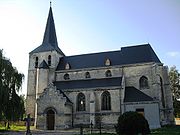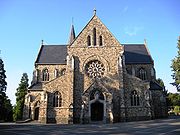.gif)
As (municipality)
Encyclopedia
As is a municipality
located in the Belgian
province of Limburg
. On January 1, 2006 As had a total population of 7,497. The total area is 22.07 km² which gives a population density
of 340 inhabitants per km².
plateau between the Demer
and Meuse River
s.
The location of the settlements close to a water course in this dry region gave rise to the villages' names: "As" is a prehistoric name for water ("ASKA") which first referred to the Bosbeek River and later the village itself.
Archaeological finds indicate an early prehistoric settlement, including objects made of flint dating from the earliest Stone Age
. The area was inhabited from 500 BC as shown by a cemetery in the field between Genk
and As. The Romans
built the road from Tongeren to Venlo
via Munsterbilzen and As. The current road next to the river and the roads to Niel and Dorne follow the course of the Roman road. However, the Romans did not establish any settlements in the area as the sandy soil was not fertile enough. After the fall of Rome, the Francs invaded the area and established
themselves in As. The Merovingian cemetery indicates that As was an important village from 500 - 700. The region started to be Christian
ised from the eighth century, and the first church was built on the site of the current Saint Aldegonde's Church. The church is first mentioned in a letter dated 1108 in which Otbert, Prince-Bishop
of Luik
reported to the abbey of Rolduc
about "income from the churches of Riemst, Genk, As and Gellik".
Niel was first mentioned in a charter of 1253 in which Arnold, Earl of Borgloon
, was granted the Villa of Dilsen with Niel and the castle of Stokkem. In 1299 the Earl of Borgloon
was recorded appointing Arnold van Gellik as pastor of As. In 1303 the Abbey was granted a perpetual lease on the village of As. The people of Niel, however, still relied on Dilsen for religious obligations, until 1721 when Pastor Bex from Dilsen created Niel as an independent parish. Bex's cousin Adam Dellecomminne became the first pastor of Niel.
Since the early Middle Ages, the original oak and birch forests were cleared more and more for agriculture and heathland fields. The present hamlets, of which Oeleinde is the oldest, developed into a farming village. In 1901 the first coal was discovered in As, which led to industrialisation. Now As is mainly a residential municipality set along large heathland fields and woodland areas.



Municipality
A municipality is essentially an urban administrative division having corporate status and usually powers of self-government. It can also be used to mean the governing body of a municipality. A municipality is a general-purpose administrative subdivision, as opposed to a special-purpose district...
located in the Belgian
Belgium
Belgium , officially the Kingdom of Belgium, is a federal state in Western Europe. It is a founding member of the European Union and hosts the EU's headquarters, and those of several other major international organisations such as NATO.Belgium is also a member of, or affiliated to, many...
province of Limburg
Limburg (Belgium)
Limburg is the easternmost province of modern Flanders, which is one of the three main political and cultural sub-divisions of modern Belgium. It is located west of the river Meuse . It borders on the Dutch provinces of North Brabant and Limburg and the Belgian provinces of Liège, Flemish Brabant...
. On January 1, 2006 As had a total population of 7,497. The total area is 22.07 km² which gives a population density
Population density
Population density is a measurement of population per unit area or unit volume. It is frequently applied to living organisms, and particularly to humans...
of 340 inhabitants per km².
History
In 1971 the municipality was formed by the merger of two villages - As and Niel-bij-As, which both lie on the Bosbeek river on the CampineCampine
The Campine is a natural region situated chiefly in north-eastern Belgium and parts of the south-western Netherlands which once consisted mainly of extensive moors, tracts of sandy heath, and wetlands...
plateau between the Demer
Demer
The Demer is an 85 km long river in eastern Belgium, right tributary of the Dijle. It flows through the Belgian provinces Limburg and Flemish Brabant. Its source is near Tongeren. It flows into the river Dijle in Werchter, Rotselaar municipality....
and Meuse River
Meuse River
The Maas or Meuse is a major European river, rising in France and flowing through Belgium and the Netherlands before draining into the North Sea...
s.
The location of the settlements close to a water course in this dry region gave rise to the villages' names: "As" is a prehistoric name for water ("ASKA") which first referred to the Bosbeek River and later the village itself.
Archaeological finds indicate an early prehistoric settlement, including objects made of flint dating from the earliest Stone Age
Stone Age
The Stone Age is a broad prehistoric period, lasting about 2.5 million years , during which humans and their predecessor species in the genus Homo, as well as the earlier partly contemporary genera Australopithecus and Paranthropus, widely used exclusively stone as their hard material in the...
. The area was inhabited from 500 BC as shown by a cemetery in the field between Genk
Genk
Genk is a city and municipality located in the Belgian province of Limburg near Hasselt. The municipality only comprises the city of Genk itself...
and As. The Romans
Ancient Rome
Ancient Rome was a thriving civilization that grew on the Italian Peninsula as early as the 8th century BC. Located along the Mediterranean Sea and centered on the city of Rome, it expanded to one of the largest empires in the ancient world....
built the road from Tongeren to Venlo
Venlo
Venlo is a municipality and a city in the southeastern Netherlands, next to the German border. It is situated in the province of Limburg.In 2001, the municipalities of Belfeld and Tegelen were merged into the municipality of Venlo. Tegelen was originally part of the Duchy of Jülich centuries ago,...
via Munsterbilzen and As. The current road next to the river and the roads to Niel and Dorne follow the course of the Roman road. However, the Romans did not establish any settlements in the area as the sandy soil was not fertile enough. After the fall of Rome, the Francs invaded the area and established
themselves in As. The Merovingian cemetery indicates that As was an important village from 500 - 700. The region started to be Christian
Christian
A Christian is a person who adheres to Christianity, an Abrahamic, monotheistic religion based on the life and teachings of Jesus of Nazareth as recorded in the Canonical gospels and the letters of the New Testament...
ised from the eighth century, and the first church was built on the site of the current Saint Aldegonde's Church. The church is first mentioned in a letter dated 1108 in which Otbert, Prince-Bishop
Prince-Bishop
A Prince-Bishop is a bishop who is a territorial Prince of the Church on account of one or more secular principalities, usually pre-existent titles of nobility held concurrently with their inherent clerical office...
of Luik
Bishopric of Liège
The Bishopric of Liège or Prince-Bishopric of Liège was a state of the Holy Roman Empire in the Low Countries in present Belgium. It acquired its status as a prince-bishopric between 980 and 985 when Bishop Notger, who had been the bishop of Liege since 972, acquired the status of Prince-Bishop...
reported to the abbey of Rolduc
Rolduc
Rolduc is the name of a medieval abbey in Kerkrade, the Netherlands, which is now a Roman Catholic seminary and an affiliated conferencing center.-History:...
about "income from the churches of Riemst, Genk, As and Gellik".
Niel was first mentioned in a charter of 1253 in which Arnold, Earl of Borgloon
Borgloon
Borgloon is a city and municipality located in the Belgian province of Limburg. On January 1, 2006 Borgloon had a total population of 10,152. The total area is 51.12 km² which gives a population density of 199 inhabitants per km². Borgloon gave its name to the former county of Loon.-External...
, was granted the Villa of Dilsen with Niel and the castle of Stokkem. In 1299 the Earl of Borgloon
Borgloon
Borgloon is a city and municipality located in the Belgian province of Limburg. On January 1, 2006 Borgloon had a total population of 10,152. The total area is 51.12 km² which gives a population density of 199 inhabitants per km². Borgloon gave its name to the former county of Loon.-External...
was recorded appointing Arnold van Gellik as pastor of As. In 1303 the Abbey was granted a perpetual lease on the village of As. The people of Niel, however, still relied on Dilsen for religious obligations, until 1721 when Pastor Bex from Dilsen created Niel as an independent parish. Bex's cousin Adam Dellecomminne became the first pastor of Niel.
Since the early Middle Ages, the original oak and birch forests were cleared more and more for agriculture and heathland fields. The present hamlets, of which Oeleinde is the oldest, developed into a farming village. In 1901 the first coal was discovered in As, which led to industrialisation. Now As is mainly a residential municipality set along large heathland fields and woodland areas.
Mayors
- 1873 - 1908 : Jan Matthijs Theunissen
- 1909 - 1927 : Jacobus Janssen
- 1927 - 1933 : Joseph Weytjens
- 1933 - 1935 : Desiré Colemont
- 1935 - 1941 : Louis Huveners
- 1941 - 1944 : Jan Lambert Dexters
- 1944 - 1947 : Koen Lagaert
- 1947 - 1953 : Hubert Hoogmartens
- 1953 - 1965 : Gisbert Marting
- 1959 - 1971 : Albert Jorissen
- 1971 - 1977 : Pierre Tilmans
- 1977 - 1983 : Albert Jorissen
- 1983 - 2006 : Jos Truyen
- 2007 - : Miel Craeghs
Sights



- The restored church of St Aldegonde
- The church of St Theresa, dating from 1930-32
- The Kolenspoor (Coal Track), an association of volunteers who present guided tours of the historic route of the former railway line from Waterschei to Eisden via As
- The former railway station, the oldest in Limburg, now restored as a pub (the Kolenspoor) and the entrance to the CampineCampineThe Campine is a natural region situated chiefly in north-eastern Belgium and parts of the south-western Netherlands which once consisted mainly of extensive moors, tracts of sandy heath, and wetlands...
National Park - The André Dumont Monument, at the place where the first coal was struck
- Two historic water mills
External links
- Official website - Available only in DutchDutch languageDutch is a West Germanic language and the native language of the majority of the population of the Netherlands, Belgium, and Suriname, the three member states of the Dutch Language Union. Most speakers live in the European Union, where it is a first language for about 23 million and a second...

